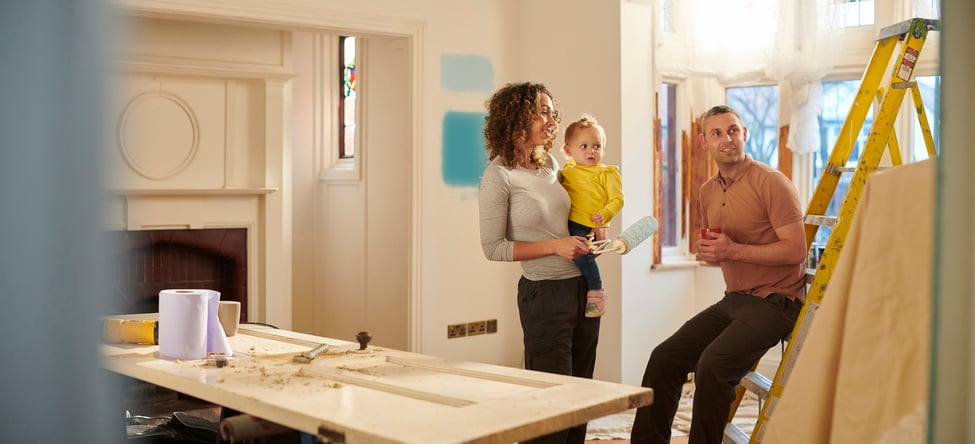Deciding to upgrade your home is exciting, whether you’re planning to enjoy the improvements yourself or boost your property’s value for a future sale. However, once you’ve envisioned the transformation, the next big question becomes: how will you pay for it?
While minor updates like fresh paint or swapping out fixtures might not break the bank, larger projects often come with unexpected costs—think floor rot, foundation issues, or outdated wiring. Fortunately, there are plenty of ways to finance your renovations and handle those surprises without derailing your plans.
Let’s explore the top options so you can confidently move forward with your renovation goals.
8 Popular Ways to Finance Home Renovations
1. Use a Home Equity Line of Credit (HELOC)
If you’ve built equity in your home over the years, a HELOC could be a great way to finance your renovation. Your equity is the difference between your home’s appraised value and what you still owe on your mortgage.
A HELOC allows you to borrow up to 65–80% of your home’s value (minus your remaining mortgage balance). For example, if your home is valued at $800,000 and you owe $300,000, you could potentially borrow $340,000:
Calculation Example:
Maximum HELOC = (80% of Home Value) - Outstanding Mortgage
= ($800,000 × 80%) - $300,000
= $640,000 - $300,000
Total HELOC = $340,000
HELOCs offer flexible repayment terms, and as long as interest rates remain stable, this option often provides a much lower rate than credit cards or personal loans. However, it’s essential to borrow responsibly—just because you’re approved for a high limit doesn’t mean you should spend it all.
2. Refinance Your Mortgage
Refinancing your mortgage is another effective way to access funds for renovations. By increasing your mortgage amount, you can incorporate renovation costs into your loan, potentially even locking in a lower interest rate.
This option is ideal if you need a specific amount and want predictable, consistent payments. Refinancing also helps avoid the temptation of overspending since you’ll only have access to the lump sum you need for your project.
3. Apply for a Personal Loan or Line of Credit
If you don’t have enough equity to tap into your home’s value, an unsecured personal loan or line of credit may be a viable option.
Personal Loan: Provides a lump sum that’s repaid over a fixed term with interest.
Personal Line of Credit: Works like a HELOC but without being tied to your home equity, offering flexibility to borrow and repay as needed.
While convenient, unsecured loans often come with higher interest rates than HELOCs or mortgages, so it’s important to weigh the cost carefully.
4. Take Out a Second Mortgage
A second mortgage allows you to borrow against your home’s value as collateral, similar to a HELOC. However, it’s disbursed as a lump sum with a fixed interest rate and repayment term.
This option is ideal for funding major projects, but be prepared for higher interest rates and additional fees, such as appraisal and legal costs. You’ll also need to manage payments for both your original and second mortgages.
5. Use a Credit Card
Credit cards are a convenient way to cover small, immediate expenses, but they’re not ideal for large-scale renovations due to high interest rates. Cash advances, in particular, can quickly spiral into unmanageable debt. This option should only be used as a last resort or for minor purchases you can pay off quickly.
6. Borrow from Family or Friends
If you have a supportive network, borrowing from family or friends might be an option. While this approach often comes with flexible repayment terms, it’s essential to establish clear expectations and agreements to avoid straining relationships.
7. Pay as You Go
For those who aren’t in a rush, paying for renovations out-of-pocket as funds become available is a low-risk approach. While this method may slow down the timeline, it prevents debt accumulation and keeps interest costs at zero.
8. Use Your Savings
If you’ve set aside money for a rainy day, tapping into your savings is one of the simplest ways to fund a renovation. This option allows you to complete your project debt-free, though it’s important to leave enough in your account for emergencies.
Which Option is Right for You?
Choosing the best way to finance home renovations depends on your financial situation, project size, and personal preferences. Some people may find that a single option meets their needs, while others might benefit from combining approaches—for instance, using a HELOC for large expenses and paying for smaller updates with savings.
A financial advisor can help you evaluate your options and create a strategy tailored to your goals. No matter which route you choose, careful planning and budgeting will help ensure your renovations are both manageable and rewarding.
Final Thoughts
Upgrading your home is an investment in your future, whether you’re enhancing your living space or increasing your property’s resale value. By understanding your financing options and choosing the right one, you can bring your vision to life without unnecessary financial stress. Ready to start your project? Explore your options today and get one step closer to creating the home of your dreams.

